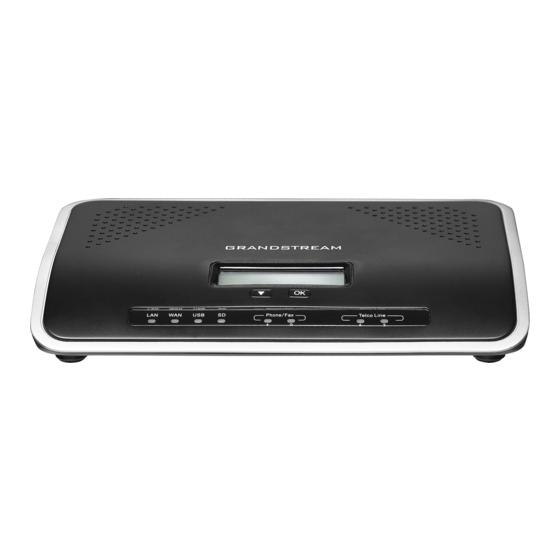
Grandstream Networks UCM6 Series Manual
Busy camp-on
Hide thumbs
Also See for UCM6 Series:
- Service manual (47 pages) ,
- Manual (31 pages) ,
- Basic configuration manual (29 pages)
Table of Contents
Advertisement
Quick Links
Advertisement
Table of Contents

Summary of Contents for Grandstream Networks UCM6 Series
- Page 1 Grandstream Networks, Inc. UCM6XXX Busy Camp-on Guide...
-
Page 2: Table Of Contents
Table of Contents OVERVIEW ........................3 CALL COMPLETION FEATURE CODE ................. 4 CALL COMPLETION FOR LOCAL EXTENSIONS ............5 Configuration ............................5 Sample Application ..........................6 CALL COMPLETION FOR TRUNKS ................7 Configuration ............................7 Using SIP Register Trunks ....................... 7 Using SIP Peer Trunks ........................ -
Page 3: Overview
OVERVIEW Busy Camp-on/Call Completion is a feature where the PBX will camp on a called party and inform the caller as soon as the called party becomes available given the previous attempted call cannot be successfully established. When trying to reach an extension which is already busy, the caller could request the UCM6XXX to camp on the called party by dialing the call completion request code. -
Page 4: Call Completion Feature Code
CALL COMPLETION FEATURE CODE The feature code for call completion request can be modified on web GUI → Call Features → Feature Codes page. The default setting is *11 for “Call Completion Request” and *12 for “Call Completion Cancel”. Figure 1: Call Completion Feature Code P a g e UCM6XXX Busy Camp-on Guide... -
Page 5: Call Completion For Local Extensions
CALL COMPLETION FOR LOCAL EXTENSIONS Configuration 1. On UCM6XXX web GUI → Extensions/Trunk → Extensions page, create or edit an extension (e.g., 2000) to bring up the dialog in below figure. 2. Click on “Features” tab and make sure the following are configured: •... -
Page 6: Sample Application
Sample Application Assuming “user A” is using UCM6XXX extension 2000, and user B is using UCM6XXX extension 2001. Both extensions have “Enable CC” selected and “CC Mode” set to “Normal” as mentioned above. 1. Extension 2000 calls extension 2001. 2. The call fails to be established due to the following possible reasons: a) Extension 2001 is busy, e.g., talking on the phone. -
Page 7: Call Completion For Trunks
CALL COMPLETION FOR TRUNKS Configuration Call completion for trunks is applicable to SIP register trunks and SIP peer trunks. Two UCM6XXXs must be first configured with SIP trunks to each other. For the sake of the following illustration, we name the two UCM6XXXs involved in this example UCM1 with IP address 192.168.6.133 and UCM2 with IP address 192.168.5.143 respectively. -
Page 8: Figure 4: Create Sip Register Trunk
Figure 4: Create SIP Register Trunk • Type: Select “Register SIP Trunk”. • Host Name: Enter the IP address of the UCM to register to. • Username: The extension number on the UCM to register to. • AuthID: Same as Username. •... -
Page 9: Using Sip Peer Trunks
7. Configure inbound and outbound rules on two UCMs to make sure the extensions on UCM1 can reach the extensions on UCM2 through the SIP register trunk and vice versa. 8. For the extensions on both UCM6XXX that you would like to use call completion, go to the UCM6XXX web GUI→... -
Page 10: Figure 7: Edit Sip Peer Trunk
Figure 7: Edit SIP Peer Trunk 1.2. Access “Advanced Settings” tab and set following options: • “Enable Heartbeat Detection”: selected. This setting is optional, if activated it will help to check the status of the trunk. • “Enable CC”: selected. Figure 8: SIP Peer Trunk –... -
Page 11: Sample Application
2. Similar to step 1, on UCM2, create a SIP peer trunk with UCM1. 3. Check the trunks status on web GUI → System Status → Dashboard. If configured successfully, the status for the trunk should show as “Reachable”. Figure 9: SIP Peer Trunk Status 4. - Page 12 b) If extension 5001 rejected the call or the call went to timeout when 1005 called 5001, 5001 is considered as available after a new call is completed. This means extension 5001 has to initiate a new call or answer another incoming call and the new call hangs up.














Need help?
Do you have a question about the UCM6 Series and is the answer not in the manual?
Questions and answers